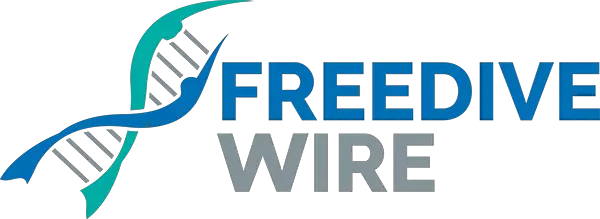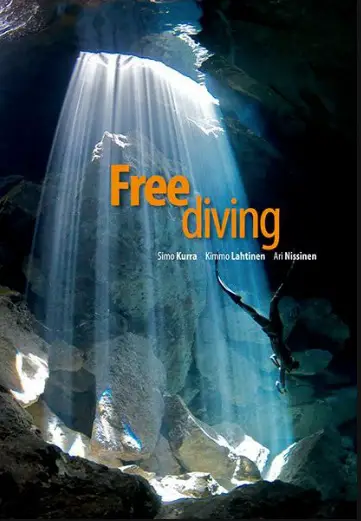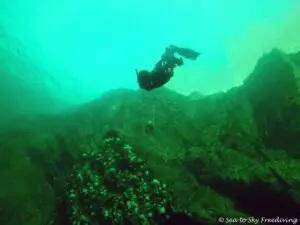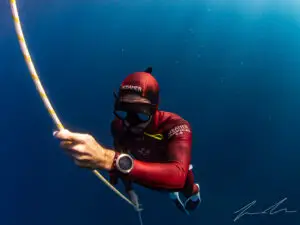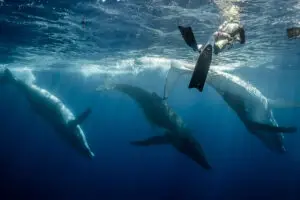This article is a short review of FreeXperience’s book “Freediving”. Written by Kimmo Lahtinen, Simo Kurra and Ari Nissinen, this book reflects years of experience in freediving education.
Reading time for this article is about 5 minutes.
Unlike most manuals of freediving out there, this book gets straight to the facts and details. Freediving courses provide ample information at all levels of education. However, most students come out of these courses with more questions than answers, and rightly so. “Freediving” fills those gaps of knowledge with detailed information that is readily understood by all readers.
Highlights of “Freediving” by FreeXperience:
- This books goes into details on human physiology and how it changes during freediving.
- Describes concepts in physics that are easy to absorb for anyone without a science background.
- Talks about different diving techniques, tricks and tips for open water diving.
- Breaks down elements on how to improve performance in pool training and dry training.
- Improves on the safety systems and rescue procedures presented in courses and gives new perspectives.
- Talks about what we often avoid discussing: the psychology of the sport and the importance this topic plays in our training.
We love to go into the details of freediving science and physiology. Hopefully that shows in our articles about lactate in the muscles or CO2 tolerance in the body. And so it was a lot fun to read through ‘Freediving’.
What I’ve enjoyed from this book is how well it can compliment any student’s education. From beginner to advanced, there are details and facts for everyone. They’re presented so that they grab your attention, and retain it.
I’ll briefly discuss two topics below. I particularly enjoyed the way they are presented and broken down for better understanding.
Teaching Freediving Physics
Let’s look at freediving physics. This is a topic I love to teach, however I recognize not everyone has a background in engineering. For instance, understanding the relationship between volume and pressure of gases can be daunting. As a result it is a difficult topic to teach.
That being said, the methodology outlined in “Freediving” and examples of calculations paint a clear picture of the topic. What appears as intimidating mathematics at first, is quickly turned into a pleasant exercise of plugging in numbers and seeing the output. This method of teaching is stimulating: it teaches the student to question and experiment. It’s novel, compared to simply accepting information as unquestionable gospel.
Psychology of Freediving
Another topic I enjoyed in this book was the psychology of freediving. In most introductory courses we teach how freediving is a mental and emotional sport. However, no one quite realizes how true this is until they have experienced it. Overtraining and burnout have always been issues for professional athletes, including freedivers. Perhaps we should emphasize this more in our education is needed.
“Freediving” describes ways to approach and deal with stress and motivation in our sport. The knowledge written here resonates years of personal experiences: both successes and failures. To learn from this, is to grow both for oneself, but also improve freediving as a sport.
In addition, the concept of the “comfort zone” is presented in this book. This is a relatively new idea, compared to the history of modern freediving. This approach gives a new perspective on how “holistic” freediving can be. Diving within one’s comfort zone and only expanding this zone little by little, allows for gradual, safe and enjoyable progress.
Educating new freedivers from the very beginning about this concept will have exceptional benefits for the sport. Reminding professional freedivers about these concepts can reduce stress in competitions and injuries.
An excellent supplement
In conclusion, “Freediving” covers every topic discussed in beginner to advanced freediving courses. It fills in gaps in knowledge, without overwhelming the reading with facts or information. “Freediving” presents just enough about a particular topic to not bore you, and will intrigue you enough to research more.
I highly recommend instructors keep a copy with them at all times when teaching. Whether its to present a different perspective on buoyancy or give more detail on how the nervous system functions. This book acts as an excellent aid and supplement to freediving courses.
Check it out here:
FreeXperience
Freediving, the book
